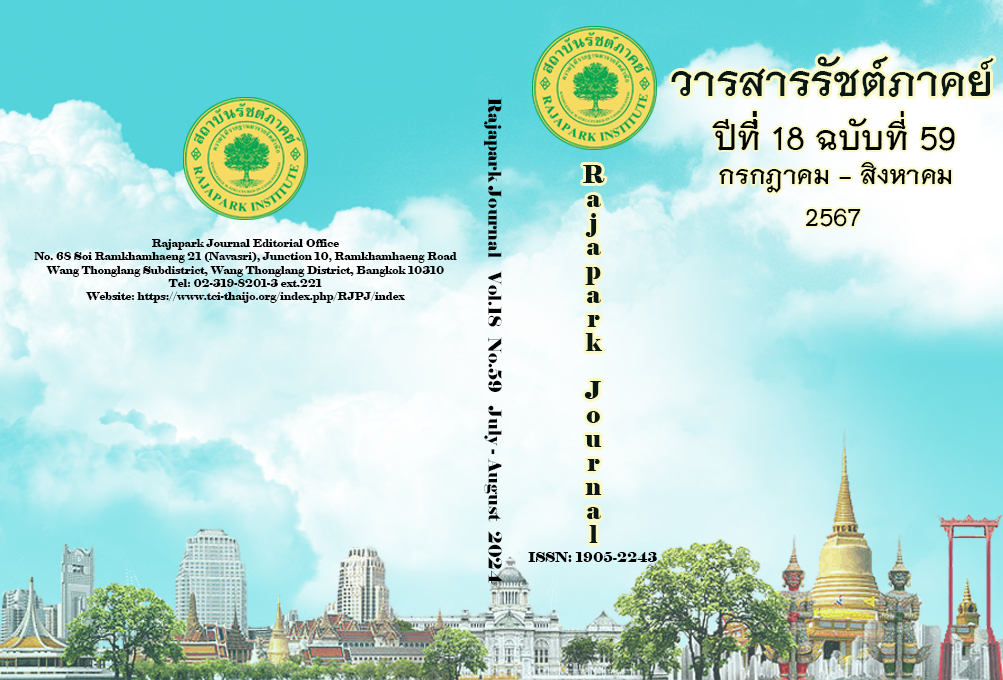A Study of the Relationships Among Potential of Tourism Components, Satisfaction and Tourists Behavior in Khao Yai National Park, Nakhon Ratchasima Province
Main Article Content
Abstract
The objectives of this research were to study (1) the variables of tourist satisfaction with the potential of tourism components; (2) the relationship between personal factors and tourist behavior; and (3) the effect of demographics on tourist satisfaction with the potential of tourism components. This research is quantitative, using a quantitative data collection method by using a convenient sampling with a group of 400 tourists who visited Khao Yai National Park, Nakhon Ratchasima Province. The instrument for data collection was an accidental sampling analyzed by using the questionnaire, the standard deviation of frequencies, percentage, mean, and standard deviation to explain the subject personal, tourist behavior, and the satisfaction of the tourist towards tourism attraction potential. The instruments of the research are Chi-square, t-test, and One-way ANOVA analysis to test the hypothesis. The results showed that the overall satisfaction level with the potential of tourism components was high, with the highest satisfaction in attractions. According to the test of the research hypothesis gender, age, domicile, education level, and income have a relationship with the satisfaction of the tourist towards the potential of tourism components. The tourist's behavior on the side of frequency of travel, period, travel date, and travel plan also has a relationship with the satisfaction of the tourist towards the potential of tourism components. The findings from this research can be used by relevant agencies to develop the tourism industry sustainably and more efficiently.
Article Details

This work is licensed under a Creative Commons Attribution-NonCommercial-NoDerivatives 4.0 International License.
Views and opinions appearing in the Journal it is the responsibility of the author of the article, and does not constitute the view and responsibility of the editorial team.
References
Best, J. (1977). Research in education. Prentice Hall.
Chomphoothong, P., Visesprapa, P., Charoensuk, C., Swangngam, N., & Sugsamrit, J. (2022). Exploratory Factor Analysis on Tourism Attraction Affecting on Intention to Visit the Agro-Tourism in Prachuap Khiri Khan Province. Journal of Business and Social Sciences Ramkhamhaeng University, 5(1), 36-52. https://so02.tci-thaijo.org/index.php/ibas/article/view/254904
Cronbach, L. J. (1990). Essentials of psychological testing (5th ed.). Harper Collins Publishers.
Department of National Parks, Wildlife and Plant Conservation. (2022). Forest resource survey report. Khao Yai National Park. Academic work group Conservation Area Administration Office 7 (Nakhon Ratchasima). https://portal.dnp.go.th/p/NakhonRatchasima
Department of National Parks, Wildlife and Plant Conservation. (2023). Number of tourists in national parks, fiscal year 2023. https://catalog.dnp.go.th/dataset/stat-tourism/resource/70ae333d-19fc-4cdb-a60c-dc43bbf74ad6
Heritage Council of Western Australia. (2022). Strategic and policy documents for the Heritage Council of Western Australia. Annual Report 2022-2023. https://www.wa.gov.au/governent/document-collections/heritage-council-of-western-australia-publications
Khao Yai National Park. (2023). Statistics on Tourists, Elderly and Disabled People Entering Khao Yai National Park in 2022–2025. Department of National Parks, Wildlife and Plant Conservation, Bangkok.
Khwantongyim, W., Na Thalang, C., & Wongmontha, S. (2023). Behavior of Thai Tourists Visiting in Multicultural Tourism Destination in the Songkhla Province. Management Sciences Valaya Alongkorn Review, 4(1), 43-55. https://so03.tci-thaijo.org/index.php /MSVAR/article/view/265680
Kotler, P., Bowen, J., & Makens, J. (2006). Marketing for Hospitality and Tourism (4th ed.). Prentice Hall.
Kudchachai, K. (2020). A Study of Motivations and Satisfaction of Thai Tourists Visiting Bangkachao Samut Prakan Province[Master’s thesis, Dhurakij Pundit University].
Likert, R. (1967). The method of constructing and attitude scale. Attitude theory and measurement. Fishbeic, Martin, Ed. Wiley & Son.
Marinao, E. (2018). Determinants of Satisfaction with the Tourist Destination. Mobilities, Tourism and Travel Behavior-Contexts and Boundaries. DOI: 10.5772/intechopen.70343
Ministry of Tourism and Sports. (2023). Tourism Policy. http://www.mots.go.th/ewt_news.php?nid=5953
Nunnally, J. C. (1987). Psychometric theory (2nd ed). McGrow-Hill.
Parasakul, L. (2017). A Comparison of the Push-factor and Pull-factor Motivations Influencing European, North and South American, and Chinese Tourists’ Decisions to Visit Thailand. Journal of Multidisciplinary in Social Sciences (JMSS), 13(1), 197-221. https://so03.tci-thaijo.org/index.php/sduhs/article/view/186593
Poltanee, I., & Boonphetkaew, U. (2018). A study on potential of tourist attractions on Tao Island in Surat Thani Province as a guideline to promote sustainable tourism. Silpakorn University e-Journal (Social Sciences, Humanities, and Arts), 38(5), 18-39. https://so05.tci-thaijo.org/index.php/sujthai/article/view/152558
Proirungrot, R. (2015). Tourist Behavior. Odeonstore.
Rovinelli, R. J., & Hambleton, R. K. (1977). On the use of content specialists in the assessment of criterion-referenced test item validity. Tijdschrift Voor Onderwijs Research, 2(2), 49-60.
Samsitkrai, C. (2020). Consumer behavior. Printing Office of Chulalongkorn University.
Saraoup, R. (2021). A Study of Destination Satisfaction Influencing Repeat Visitation to Fang Hot Springs Doi Pha Hom Pok National Park, Chiangmai[Master’s thesis, Dhurakij Pundit University].
Suebsri, O. Rattana, K., & Pattaratuma, P. (2021). Tourist’s Satisfaction on Nature Trail in Phu Pha Thoep National Park, Mukdahan Province. Journal of Humanities and Social Sciences Ubon Ratchathani Rajabhat University, 13(1), 37-49. https://so01.tci-thaijo.org/index.php/humanjubru/article/view/248825
Trachuwanich, P., & Punnoi, N. (2022). Tourism Behavior of Quality Tourists in Thailand. Sarasatr, 5(3), 97-508. https://so05.tci-thaijo.org/index.php/sarasatr/article/view/259069
Um, T., & Chung, N. (2021). Does smart tourism technology matter? Lessons from three smart tourism cities in South Korea. Asia Pacific Journal of Tourism Research, 26(4), 396-414. https://doi.org/10.1080/10941665.2019.1595691
Western, T. (2008). Five A's of Toursim. Tourism Western Australia.
World Economic Forum. (2023). Travel & Tourism Development Index–TTCI Report, 2023, INSIGHT REPORT MAY 2023. In collaboration with the University of Surrey. https://www3.weforum.org/docs/WEF_Travel_and_Tourism_Development_Index_2024.pdf
Yamane, T. (1973). Statistics: An Introductory Analysis (2nd ed.). Harper and Row.
Zeithaml, V. A., Bitner, M. J., & Gremler, D. D. (2009). Services Marketing: Integrating Customer Focus across the Firm (5th ed.). McGraw-Hill and Irwin.


